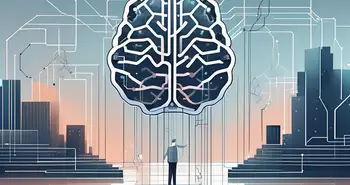The Fundamentals of Blockchain Technology

Blockchain technology has been gaining significant attention in recent years, revolutionizing various industries and promising to reshape the way we transact and share information. In this article, I will delve into the fundamentals of blockchain technology, explaining its concept, history, key components, different types, and its role in different industries. Whether you are a novice or someone well-versed in the subject, this article will provide you with valuable insights into the world of blockchain technology.
Understanding Blockchain Technology
Before we dive into the intricacies of blockchain technology, it is important to grasp its fundamental concept. At its core, blockchain technology is a decentralized and distributed ledger that records transactions across multiple computers or nodes. It ensures transparency, immutability, and security, making it an attractive alternative to traditional centralized systems.
Blockchain technology has revolutionized the way data is stored and shared in the digital world. By utilizing a network of nodes to validate and record transactions, blockchain eliminates the need for intermediaries, reducing costs and increasing efficiency. This innovative approach has found applications beyond cryptocurrencies, including supply chain management, voting systems, and smart contracts.
The Concept of Blockchain
A blockchain consists of a sequence of blocks, each containing a set of transactions. These blocks are linked together through cryptographic hashes, forming a chain. Every participant in the blockchain network has a copy of the entire chain, making it difficult for a single entity to manipulate or alter the data.
The decentralized nature of blockchain ensures that no single point of failure exists, enhancing the security and reliability of the system. Each block in the chain contains a reference to the previous block, creating a chronological and tamper-evident record of transactions. This transparency and auditability are key features that have garnered interest from industries seeking to improve data integrity.
How Blockchain Works
When a new transaction is initiated, it is bundled with other pending transactions and added to a block. Miners, who are specialized nodes in the network, compete to solve complex mathematical puzzles to validate the transactions and add the block to the chain. Once added, the block becomes permanent and cannot be modified without consensus from the majority of the network participants.
The consensus mechanism employed in blockchain networks, such as Proof of Work or Proof of Stake, ensures that all nodes agree on the validity of transactions before they are added to the chain. This distributed consensus model eliminates the need for a central authority and establishes trust among participants through cryptographic algorithms.
The History of Blockchain
The inception of blockchain technology can be traced back to the release of Bitcoin in 2009. Bitcoin, the first decentralized cryptocurrency, introduced the concept of a blockchain as a way to secure and authenticate transactions without the need for a central authority.
The Inception of Blockchain
Satoshi Nakamoto, the anonymous creator of Bitcoin, designed the blockchain to enable peer-to-peer transactions without relying on banks or financial intermediaries. This breakthrough innovation laid the foundation for a new era of digital currencies and decentralized applications.
Evolution and Growth of Blockchain
Since its introduction, blockchain technology has evolved beyond cryptocurrencies. It now encompasses a wide range of applications, including supply chain management, healthcare record-keeping, and smart contracts. The growth of blockchain has led to the emergence of various platforms and protocols, each catering to specific needs and use cases.
Key Components of Blockchain Technology
Blocks and Chains: The Backbone of Blockchain
As mentioned earlier, blocks are the building blocks of a blockchain. Each block consists of a header containing metadata and a list of transactions. Additionally, blocks contain a unique identifier called a hash, which is calculated using cryptographic algorithms. The chain refers to the interconnected sequence of blocks, forming a chronological record of transactions.
Decentralization in Blockchain
Decentralization is a fundamental feature of blockchain technology. Unlike traditional centralized systems where a single entity or authority controls the data, blockchain distributes the data across multiple nodes in the network. This distributed nature ensures that no single entity has complete control over the data, enhancing transparency and eliminating a single point of failure.
Cryptography in Blockchain
Cryptography plays a vital role in securing blockchain transactions. It involves the use of mathematical algorithms to convert data into an unreadable format, known as ciphertext. Participants in the blockchain network use public-key cryptography to authenticate and validate transactions, ensuring the integrity and confidentiality of the data.
Types of Blockchain
Public Blockchains
Public blockchains, such as Bitcoin and Ethereum, are open to anyone and allow anyone to participate in the network. They offer high levels of transparency and security but may have slower transaction speeds due to their open nature.
Private Blockchains
Private blockchains, as the name suggests, are restricted to a select group of participants. They are often used within organizations or consortiums to streamline operations and improve efficiency. Private blockchains offer faster transaction speeds but may have lower levels of transparency compared to public blockchains.
Consortium Blockchains
Consortium blockchains are a hybrid between public and private blockchains. They are governed by multiple organizations or entities that agree to collaborate and share control over the network. Consortium blockchains combine the benefits of both public and private blockchains, offering a balance between transparency and privacy.
The Role of Blockchain in Different Industries
Blockchain in Finance
The financial industry has embraced blockchain technology for its potential to streamline processes, reduce costs, and enhance security. Blockchain enables faster and more secure cross-border transactions, eliminates the need for intermediaries, and provides a transparent record of financial transactions.
Blockchain in Healthcare
In the healthcare industry, blockchain technology offers a secure and decentralized platform for storing and sharing patient data. It ensures the privacy of patient information, enables seamless interoperability between different healthcare providers, and reduces medical fraud and errors.
Blockchain in Supply Chain Management
Supply chain management involves tracking and verifying the movement of goods from the source to the end consumer. Blockchain technology provides a transparent and immutable record of every transaction and movement within the supply chain, reducing fraud, improving traceability, and enhancing overall efficiency.
My Expert Advice
As an expert in blockchain technology, I want to emphasize the importance of staying updated on the latest advancements and developments in this rapidly evolving field. Blockchain has the potential to disrupt various industries, and being knowledgeable about its applications and potential benefits can give you a competitive edge in your professional endeavors.
I personally witnessed the transformative power of blockchain technology when I led a team in developing a supply chain management solution for a global retail company. By implementing blockchain, we were able to eliminate inefficiencies, improve traceability, and enhance trust among all participants in the supply chain. The project resulted in significant cost savings and increased customer satisfaction.
Frequently Asked Questions (FAQ)
What is blockchain technology?
Blockchain technology is a decentralized and distributed ledger that records transactions across multiple computers or nodes, ensuring transparency, immutability, and security.
How does blockchain work?
When a new transaction is initiated, it is bundled with other pending transactions and added to a block. Miners validate the transactions and add the block to the chain.
What are the key components of blockchain technology?
The key components of blockchain technology include blocks, chains, decentralization, and cryptography.
What are the different types of blockchain?
The different types of blockchain are public blockchains, private blockchains, and consortium blockchains.
What is the role of blockchain in finance?
Blockchain technology in finance enables faster and more secure cross-border transactions, eliminates intermediaries, and provides a transparent record of financial transactions.
How does blockchain benefit the healthcare industry?
In the healthcare industry, blockchain technology ensures the privacy of patient data, enhances interoperability, and reduces medical fraud and errors.
How does blockchain improve supply chain management?
Blockchain improves supply chain management by providing a transparent and immutable record of transactions, reducing fraud, improving traceability, and enhancing overall efficiency.
In conclusion, blockchain technology is a disruptive force that has the potential to transform various industries. Understanding its fundamentals, history, key components, different types, and role in different industries is crucial in unlocking its full potential. By staying informed and exploring its applications, you can leverage blockchain technology to drive innovation and stay ahead in the ever-changing digital landscape.
Ready to experience the future of trading with the benefits of blockchain technology? Join Morpher today, the revolutionary trading platform that offers zero fees, infinite liquidity, and the flexibility of fractional investing and short selling. With Morpher, you're in control with a secure, non-custodial wallet, and you can amplify your trades with up to 10x leverage. Embrace a unique trading experience with Virtual Futures on the Ethereum Blockchain. Sign Up and Get Your Free Sign Up Bonus to start transforming your investment journey across stocks, cryptocurrencies, forex, and more with Morpher.

Disclaimer: All investments involve risk, and the past performance of a security, industry, sector, market, financial product, trading strategy, or individual’s trading does not guarantee future results or returns. Investors are fully responsible for any investment decisions they make. Such decisions should be based solely on an evaluation of their financial circumstances, investment objectives, risk tolerance, and liquidity needs. This post does not constitute investment advice.

Painless trading for everyone
Hundreds of markets all in one place - Apple, Bitcoin, Gold, Watches, NFTs, Sneakers and so much more.

Painless trading for everyone
Hundreds of markets all in one place - Apple, Bitcoin, Gold, Watches, NFTs, Sneakers and so much more.









